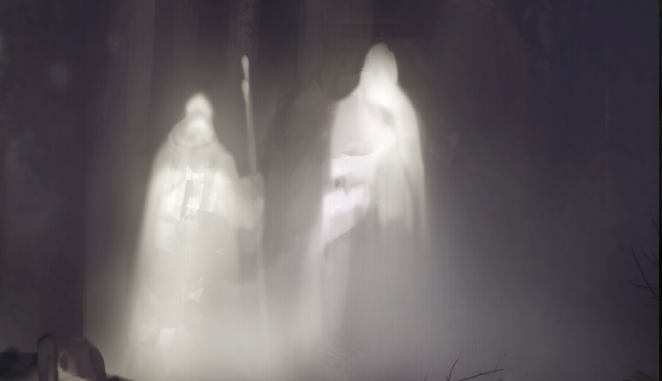
Recently, Free League Publishing offered the Symbaroum – Core Rulebook for free. Nominated for Best Game at the Origins Awards, I wanted to check this one out because the game is one of the few from Free League that does not utilize their award-winning Mutant: Year Zero engine. What I found in my RPG-View Copy was a book that has all of the hallmarks of a Free League product, amazing art, epic setting, and crisp mechanics.
“Book 1: The World of Symbaroum”
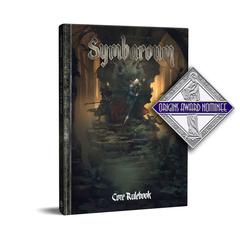 By far and away, the two most important parts of Symbaroum are the artwork (more on that later) and the lore. The world of Symbaroum is changing after a devastating war. Humanity won the war but their land was destroyed in the process. Left with few options, the queen orders the peasantry over the mountains to recolonize the land to the north that their ancestors fled from. The north, beyond a massive mountain range, is home to a fallen kingdom overrun by barbarians and monsters, a land edged by the ocean and a forest that dominates the greater part of the continent. Everyone and everything in this world exists in a terrible, dark state. This isn’t impoverished grimdark, it’s corrupted grimdark. This is a world with classic fantasy creatures but not given the same slant as D&D or Tolkien.
By far and away, the two most important parts of Symbaroum are the artwork (more on that later) and the lore. The world of Symbaroum is changing after a devastating war. Humanity won the war but their land was destroyed in the process. Left with few options, the queen orders the peasantry over the mountains to recolonize the land to the north that their ancestors fled from. The north, beyond a massive mountain range, is home to a fallen kingdom overrun by barbarians and monsters, a land edged by the ocean and a forest that dominates the greater part of the continent. Everyone and everything in this world exists in a terrible, dark state. This isn’t impoverished grimdark, it’s corrupted grimdark. This is a world with classic fantasy creatures but not given the same slant as D&D or Tolkien.
“Book 2: Player’s Guide”
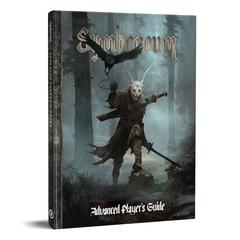 Originally conceived by Team Järnringen before they merged with fellow Swedish publisher, Free League Publishing (Fria Ligan), this game uses an option that is not OGL, but is based around the d20 and other standard RPG dice.
Originally conceived by Team Järnringen before they merged with fellow Swedish publisher, Free League Publishing (Fria Ligan), this game uses an option that is not OGL, but is based around the d20 and other standard RPG dice.
Much like the dice, character creation follows the standard path of most RPGs: Pick an Occupation (class), set values among the eight Attributes, select a Race, choose Traits (Race-based), Abilities and Powers, and give your Shadow a description. There’s more (equipment, history, relations, etc.), but most of these picks are the expected in an RPG.
For Occupations you can choose to be a Warrior and its specializations (Berserker, Duelist, Captain, Sellsword, and Knight), a Mystic and its specializations (Witch, Sorcerer, Theurg (priest), Wizard, and Self-taught Mystic), or a Rogue and its specialization (Charlatan, Witchhunter, Thug, Treasure-hunter, and Ranger).
Player races in this game include humans (Ambrian or Barbarian), changelings, ogres, and goblins. Dwarves are mentioned in the history of the area, but not listed as PCs or monsters in the core rulebook. Instead, rules to play as a dwarf appear in Symbaroum – Advanced Player’s Guide, as do a few other races that appear as monsters only in the core rulebook. Races offer Traits, which are options or powers your character starts the game with. An Ambrian human gets either Contacts (Persuasive Test to “recall” a contact) or Privileged (more starting coin and a re-roll option on certain social challenges). Changelings get Long-lived, but have to purchase Shapeshifter.
Each character has Attributes: Accurate, Cunning, Discreet, Persuasive, Quick, Resolute, Strong, and Vigilant. Character creation rules suggest point buy or standard array to obtain the Attribute values, which range from 5 to 15. From the eight primary Attributes, there are four Secondary Attributes that build off Strong, Quick, and Resolute.
Success Tests, the game’s core mechanic, uses a roll low system. For a Success Test, you’ll pick the appropriate Attribute (each of your stats has a rating of 5 to 15), and, for most simple challenges, attempt to roll a result equal to or less than your Attribute rating. However, for more difficult challenges, the GM introduces a modifier of +5 to -5 to your character’s Attribute.
For attacks, your roll is modified by your target’s Defense (their Quick Attribute less their armor’s impeding value), which, like regular GM modifiers, results in a +5 to your Attribute (for poorly armored enemies) to -5.
The parts that are more specific to Symbaroum are the Abilities and Powers and your character’s Shadow. Traits, Abilities and Powers are the options that give your character their mechanical uniqueness. Your PC starts with either “two abilities or powers at novice level and one at adept level, but you may instead choose to start with five abilities at novice level and none at adept level.” In addition to these options, most races start with a few Traits at no cost.
In this world, Shadow, the destruction of nature to make way for the civilized races, is a major theme. Shadow is a measure of humanity’s corruption of the land and themselves in fostering the destruction. If left unchecked, it can lead to your character’s corruption and downfall. As your characters adventure in this world, they’ll become tainted and corrupted by Shadow. This will lead your characters down a dark path, one that they may not return from intact.
“Book 3: Game Master’s Guide”
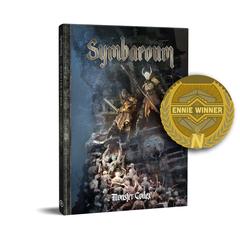 Combat, the heart and soul of any fantasy RPG it seems, is detailed in the “Player’s Rules” but I’m going to dig into it here to match it with some GM information. Initiative in combat is based on your Quick. Once it’s your character’s turn, you have two Actions (Combat and Movement, or two Movement actions) as well as an unlimited number of Reactions (defending yourself) and Free Actions (roleplaying options). Combat is crunchier than Dungeons & Dragons 5e, but not as involved as Pathfinder 1e. There are options like Flanking. Shields not only add to your defense, but prevent Long weapons (in this game, weapon length matters) from having an advantage (+2 to any attack made with them and 1d4 additional damage) against you.
Combat, the heart and soul of any fantasy RPG it seems, is detailed in the “Player’s Rules” but I’m going to dig into it here to match it with some GM information. Initiative in combat is based on your Quick. Once it’s your character’s turn, you have two Actions (Combat and Movement, or two Movement actions) as well as an unlimited number of Reactions (defending yourself) and Free Actions (roleplaying options). Combat is crunchier than Dungeons & Dragons 5e, but not as involved as Pathfinder 1e. There are options like Flanking. Shields not only add to your defense, but prevent Long weapons (in this game, weapon length matters) from having an advantage (+2 to any attack made with them and 1d4 additional damage) against you.
Damage counts against the character’s Toughness (Strong Attribute or 10, whichever is higher). While Toughness stands in for Hit Points, there’s a caveat, each character has a Pain Threshold. If a single attack deals half the character’s Strong in Damage, they are either knocked down or the enemy gets an additional attack (player’s choice). Healing is old school with PCs recovering one point of Toughness per day; otherwise, they need to use herbs, abilities, or powers to heal more quickly.
In terms of winning layout, the biggest victory is the one-page guide to the rules of combat in this game. Having a one-sheet improves the flow of combat a great deal.
Adventure, Monsters, and More
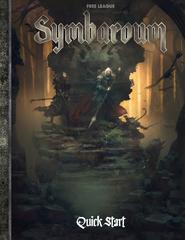 While there are additional products for Symbaroum, the core rulebook has all of the rules you’ll need to start playing. There are artifacts as well as the setting and monsters, including rules to create your own creatures with options that can be tailored to the PC’s level. What are monsters in this world? Elves, long-lived defenders of the forest who cycle between life and long periods of dormancy. Trolls, huge monsters that range from brutes to the trolls of legend that ask riddles and the like. Spiders, various kinds of abominations, and undead. There are enough types of enemies in the core rulebook to craft a good opening to your campaign.
While there are additional products for Symbaroum, the core rulebook has all of the rules you’ll need to start playing. There are artifacts as well as the setting and monsters, including rules to create your own creatures with options that can be tailored to the PC’s level. What are monsters in this world? Elves, long-lived defenders of the forest who cycle between life and long periods of dormancy. Trolls, huge monsters that range from brutes to the trolls of legend that ask riddles and the like. Spiders, various kinds of abominations, and undead. There are enough types of enemies in the core rulebook to craft a good opening to your campaign.
Artwork
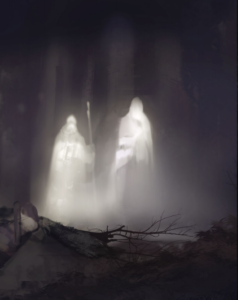 Among the likely legacies of Free League is the ultimate realization of tabletop roleplaying games as tabletop art books. Since the beginning of RPGs, art has played a lead role in any product. One of the few RPG-related documentaries, Eye of Beholder: The Art of Dungeons & Dragons, focuses on D&D’s art. While D&D has always focused on epic cover art, their interiors are a mixed bag. Not so with a Free League production. Every piece of art in one of Free League’s RPGs is a fully realized painting. In the case of Symbaroum, all of the art is by Martin Grip and the graphic design is handled by Johan Nohr. Together, they create a grimdark world that realizes the descriptions of the setting. Everything feels desperate, ancient, dark, and deadly. The world is foreboding, the heroes are murderers, the monsters are horrors, and together there can only be violence, never joy. Martin Grip brings that in his imagery crafting a dreary world that your characters will fight against instead of for.
Among the likely legacies of Free League is the ultimate realization of tabletop roleplaying games as tabletop art books. Since the beginning of RPGs, art has played a lead role in any product. One of the few RPG-related documentaries, Eye of Beholder: The Art of Dungeons & Dragons, focuses on D&D’s art. While D&D has always focused on epic cover art, their interiors are a mixed bag. Not so with a Free League production. Every piece of art in one of Free League’s RPGs is a fully realized painting. In the case of Symbaroum, all of the art is by Martin Grip and the graphic design is handled by Johan Nohr. Together, they create a grimdark world that realizes the descriptions of the setting. Everything feels desperate, ancient, dark, and deadly. The world is foreboding, the heroes are murderers, the monsters are horrors, and together there can only be violence, never joy. Martin Grip brings that in his imagery crafting a dreary world that your characters will fight against instead of for.
Should You Play Symbaroum?
The books are beautiful. The artwork strikes a mood that’s worth a thousand words of flavor text. This is not a standalone product, but part of a line with multiple books to pull from. If you’re looking for a fantasy system that gives you more crunch than 5e, but adds in powers for most characters, old school slog options that make combats deadly, and a reason to try to find balance before your Shadow does you in, I’d recommend Symbaroum – Core Rulebook from Free League Publishing available at DriveThruRPG, Amazon, Free League’s site, and more.
But don’t take my word for it, try the Symbaroum – Quick Start for free at DriveThruRPG. (Linda Whitson’s review of the Quickstart is here.)
Egg Embry participates in the OneBookShelf Affiliate Program and Amazon Associates. These programs provide advertising fees by linking to DriveThruRPG and Amazon.
